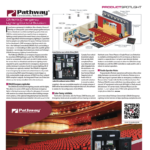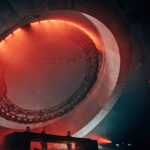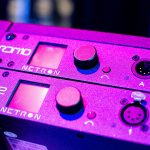Amid a growing field of computer-based lighting pre-visualization systems, lighting designer Charles Kirby and his company have been busy building and improving on a more organic and interactive method of modeling light. By taking advantage of today’s fiber-optic and LED technologies, Thematics is giving designers — and students of the craft — a way to build fully-operational scale models of their lighting designs.
The LightBox system from Thematics is a modular system for creating a scaled replica of a light plot. The basis of the system is the ModelBox, a structure that can be purchased in various sizes based on the physical size and scale of models to be lit. The ModelBox is basically a big kid’s erector set. Using various lengths of railing, you can “build” your lighting positions around a scaled performance space or stage.
The second set of key components in the system are the light fixtures. Using small halogen fixtures, three-color LED modules, and specialized fiber optic fixtures, the creative user can replicate almost any type of light source they choose. By attaching these “fixtures” to the lighting positions in the ModelBox, users can quickly begin to experiment with direction, color, and quality of light.
The third key to the system is a full range of halogen and LED fiber-optic illuminators purpose-built for the LightBox system. Using DMX512-controlled multi-channel and multi-output “dimmer packs,” users can further manipulate their miniature lighting rig.
In addition to their recently released LED-driven fiber optic illuminators, Thematics has also delivered a new piece of control software dubbed L.B.O.S. (for LightBox Operating System). In its first iteration, the software gives users a laptop-friendly lighting console with DMX512 output capability. With this software, Thematics hopes to give users better control over cueing and tracking during their scaled experimentation. Working closely with major console manufacturers, Thematics included compatibility with many of the major desks being used in today’s theatres. For L.B.O.S. users, this means a simple transition from pre-cueing in the lab to tech rehearsals in the theatre. By combining venue, light fixtures, dimming and control, the LightBox system is designed to be a fully configurable package that suits the modeling needs of any production space.
Opening the Box
The attention to detail and dedication to the end-user is seen throughout the product range. The fiber optic fixtures, which are designed to emulate ERS fixtures, are available in beam angles that match today’s most popular and widely available spots. The newest line of LED-driven fiber optic illuminators are color balanced using dichroic filters to match the output of typical halogen fixtures so that colors in the LightBox match colors on stage as closely as possible.
The best news about the platform is that Thematics is not standing still. They continue to innovate, working with various manufacturers to re-purpose new technologies in novel and unique applications. One of the newest pieces to be sold as part of the LightBox line is the CycBox. The CycBox is a 20”x20” Plexiglas backdrop illuminated using Color Kinetics iCove fixtures. By making use of this product, you can emulate a cyclorama backdrop lit in almost any color imaginable.
The Box Scores
Scenic artists have been pre-visualizing their creative concepts for centuries — it’s called model making. And while the personal computing revolution has brought some of these capabilities to lighting designers, the truth is that it’s just not the same. The ability to grab on to a piece of clay, a piece of balsa wood, the handle of a paintbrush — these experiences have not been replicated for lighting designers. No amount of staring at a two dimensional computer screen can give a designer an accurate feel for the quality of light that is produced by a combination of intensity, color, angle, and beam characteristics.
This is where LightBox excels. And that is why the designers of the system don’t see it as a replacement for modern on-screen pre-visualization programs, but as a supplement. It’s another tool, and a good one, for those who design with light.


